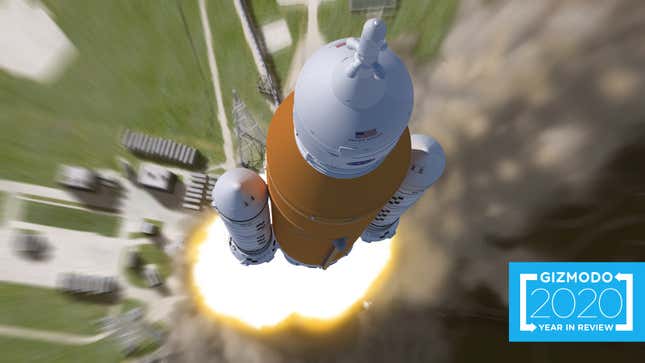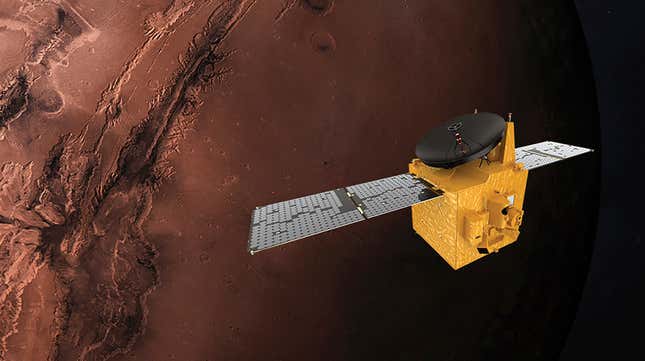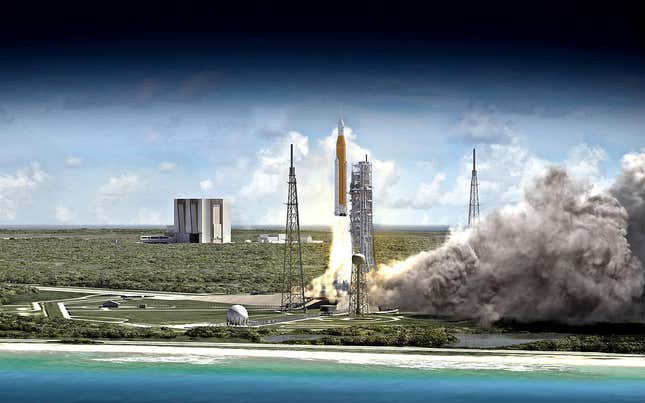
Blast off to adventure in the amazing year 2021! No doubt, we’re expecting a ton of cool and exciting space-related happenings next year, with these stories being among the most highly anticipated.
Three—count ‘em—three mission to Mars
Our ability to study Mars will take a gigantic leap forward in 2021 owing to the arrival of three distinct missions.
Launched on July 30, 2020, NASA’s Mars rover Perseverance will arrive at the Red Planet on February 18. Should the landing go well, Perseverance will be the fifth rover to reach Mars, the others being Sojourner, Spirit, Opportunity, and Curiosity (other famous probes, like NASA’s InSight, are landers, not rovers). This six-wheeled, 2,260-pound vehicle is packed with instruments, including 23 different cameras, a device to monitor the Martian weather, an ultraviolet spectrometer to scan the surface at microscopic scales, and a ground-penetrating radar, among many other cool toys.

Excitingly, Perseverance will take samples of the Martian surface and deposit them in small canisters, which will be retrieved and brought back to Earth during a subsequent mission.
The rover will be landing at Jezero crater, the site of a former lake, where Perseverance will hunt for signs of ancient life. Perseverance is also equipped with a tiny helicopter named Ingenuity, which is poised to become the first aircraft to take flight on another planet, which, serious goosebumps.

On April 23, China’s Tianwen-1 mission will arrive at Mars. This ambitious mission will see the deployment of 13 different scientific payloads, seven of which are on an orbiter and six on a rover. The orbiter will use its radar, spectrometer, magnetometer, and other instruments to study Mars from orbit. The 529-pound rover, with its cameras, ground-penetrating radar, magnetic field detector, surface compound detector, and other instruments, will study the Utopia Planitia region of the Martian surface. Tianwen-1 represents China’s first mission to the Red Planet.

The United Arab Emirates (UAE) is also conducting its first mission to Mars in the form of the Hope mission. The 3,000-pound satellite will arrive at Mars in February, where it will study the planet’s atmosphere and weather. The probe will enter into a unique equatorial orbit, where it will move in the same direction as the planet’s rotation. This will allow Hope’s instruments to focus on a single target for prolonged periods.
Our Moon will be the place to be
The Moon is a very cool place again, especially given the big news from this year that it hosts more water than we thought and that this water is practically everywhere. Some upcoming missions in 2021 will continue to improve our understanding of Earth’s large natural satellite.

In July, the private Pittsburgh-based space firm Astrobotic Technology will launch its Peregrine Mission One for NASA. The four-legged probe will land on the northeastern face of the Moon’s visible side in a region called Lacus Mortis. Among the many items on board, Peregrine will deliver NASA instruments for testing navigation and landing technology. The lander will also deposit the DNA of legendary sci-fi writer Arthur C. Clarke, along with the DNA and cremated remains of other individuals.
Private company Intuitive Machines will also launch a commercial lander, named Nova-C, to the Moon during the summer of 2021. The lander will “capture raw optical images of the lunar surface and convert them into Terrain Relative Navigation measurements to land within 200 meters [660 feet] of its intended landing site,” according to the Houston-based company.
Russia will be returning to the Moon in 2024, sending its Luna 25 lander to the Boguslavsky Crater near the lunar south pole. The probe will be equipped with eight science instruments, which it will use to explore the region and search for signs of water-ice. The last Russian mission to the Moon was in 1976, with the Soviet Union’s Luna 24 mission.
India’s Chandrayaan-3 mission will involve a soft landing of a rover at the lunar south pole. Launch is scheduled for late 2021, but it could be pushed to 2022. Hopefully this mission will go better than Chandrayaan-2, in which the Vikram probe crashed on the lunar surface following a communications glitch.
Make rockets go now
Some very important launches are scheduled for 2021, perhaps none as important as the inaugural launch of NASA’s Space Launch System (SLS).

This is the rocket that will supposedly deliver astronauts to the Moon in 2024 as part of NASA’s Artemis program, and eventually humans to Mars. The first version of this gigantic rocket will be capable of delivering more than 27 metric tons, or 59,500 pounds, to orbits farther than the Moon and reach speeds approaching 24,500 miles per hour (39,400 k/hr). The inaugural launch is scheduled for November 2021, when the rocket will deliver an uncrewed Orion capsule to orbit.
With Joe Biden being sworn in as U.S. president in January 2021, we should learn more about his administration’s NASA policies and whether the space agency will still be expected to send a crew to the lunar surface in 2024.

2021 should be an exciting year for SpaceX, as the Elon Musk-led company looks to send its 165-foot-tall (50-meter) Starship into orbit. This next-generation rocket is meant to carry cargo and passengers to Earth orbit, the Moon, and Mars. The company will also continue to deliver its sizable batches of Starlink satellites, as SpaceX builds its broadband internet constellation.
Other notable launches in 2021 include Blue Origin’s New Glenn rocket with a reusable first stage, United Launch Alliance’s Vulcan rocket, a Mitsubishi Heavy Industries H3 rocket, and Arianespace’s Ariane 6 rocket.
We’re also expecting an uncrewed launch of Boeing’s CST-100 Starliner spacecraft in January, with a possible crewed launch in the summer. The troubled program is behind schedule following a botched trial run and a subsequent report from NASA outlining no less than 80 recommendations for the private aerospace partner to put into practice. That said, the success of SpaceX’s CrewDragon spacecraft in 2020 means NASA already has a viable option for delivering astronauts to space.
After numerous delays and much anticipation, NASA will launch (fingers firmly crossed) its James Webb Space Telescope on October 31, 2021. This next-gen infrared telescope will operate at the Earth-Sun L2 Lagrange point, which is just shy of 1 million miles from Earth. From this vantage point, JWST will gaze upon the early universe, study galaxies and supermassive black holes, and provide new insights into exoplanets, including atmospheric composition and possibly even habitability.

Other notable launches in 2021 include NASA’s Lucy spacecraft, which will depart for Jupiter’s trojan asteroids at some point in October or November, and NASA’s Double Asteroid Redirection Test, which is scheduled to launch in late July. The DART spacecraft will visit the double asteroid Didymos and then deliberately smash into the object in order to test our ability to redirect a potentially dangerous asteroid.
Ongoing adventures in deep space
Remember NASA’s Juno spacecraft—the probe responsible for those incredible images of Jupiter? And how it detected shallow lightning and mushy hail on the gas giant?

Sadly, it’s almost the end of the line for Juno, as NASA plans to deorbit the spacecraft and have it disintegrate in Jupiter’s atmosphere on July 16 (they’re doing this to prevent contamination of the Jovian system). On a positive note, the mission lasted 41 months longer than NASA initially intended, so there’s that.
The Japan Aerospace Exploration Agency (JAXA) is the only nation to successfully collect surface samples from an asteroid (Hayabusa2 returned with samples from asteroid Ryugu earlier this month), but NASA’s OSIRIS-Rex spacecraft, currently at Bennu, may have a storage chamber filled with debris collected from the surface of that asteroid. OSIRIS-REx will leave Bennu in March but won’t arrive at Earth until September 2023.
NASA’s Parker Solar Probe will perform three perihelia (closest orbital approach to the Sun) in 2021, as it inches increasingly closer to its eventual doom, which will probably happen in 2025. The spacecraft will also zip past Venus in October, coming to within 2,352 miles (3,786 km) of the planet. This flyby of Venus will send the probe on a path that will make it the closest human-built object to the Sun (a record it already holds). ESA’s Solar Orbiter, which is also studying the Sun, will officially enter into the main stage of its mission in November, but the probe is already doing some mind-blowing work.
ESA’s Bepi Colombo is scheduled to enter Mercury’s orbit in late 2025, but it’ll make a close approach to Venus on August 10, 2021. For this second gravity assist, Bepi Colombo will come to within 343 miles (552 km) of Venus.
Space adventures closer to home
Activities aboard the International Space Station will proceed as usual, with the Expedition 64 crew expected to perform the lion’s share of work, making good use of their shiny new Nanorocks Bishop Airlock and performing a bunch of cool science experiments.
Speaking of space stations, China is expected to make a great leap forward with its very own. The country will launch the Tianhe space station module at some point in 2021, and it will serve as the foundational element of the overall space station, which should be completed by 2025.

The Vera C. Rubin Observatory in Chile won’t achieve full power until October 2022, but its wide-field reflecting telescope will see its first light in 2021. Astronomers will use the facility to capture 1,000 images each night, surveying nearby stars and distant galaxies, unless Elon Musk’s Starlink gets in the way.
Celestial stuff
Amateur astronomers have some notable events to look forward to in the coming year, including a total lunar eclipse on May 26 that will be visible in all 50 U.S. states (including most of Alaska), most of Canada, southeast Asia, Australia, Oceania, and parts of South America. A total solar eclipse will happen on December 4, but it’ll be limited to Antarctica, with a partial solar eclipse visible from South Africa.
Potentially hazardous asteroid Apophis will make a close-ish approach of Earth in March, when it will come to within 10.5 million miles (16.9 million km) of our planet. This will be our final chance to observe the asteroid with radar imaging before its very close approach in 2029, when it will come to within 19,000 miles (31,000 kilometers) of Earth, which is one-tenth the distance of Earth to the Moon. Apophis has an exceptionally low but nonzero chance of hitting Earth in 2068.
So, strap in and pack your Kool-aid—we’ve got a big year ahead of us.